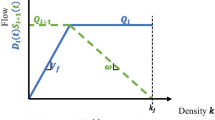Abstract
A lot of studies have been made to characterize and model sources of ATM traffic (voice, data, video) and to evaluate the performance of a multiplexer whose input is a superposition of these sources, using different methods and techniques (fluid flow, matrix-analytic, etc.). However, in order to better understand the end-to-end performance of ATM connections, characterizations and models of ATM traffic inside the network (i.e. after passage through one or more network elements) are needed. In this paper we intend to study the following problems: (i) Traffic profile of an ATM connection after being policed, in particular worst case traffic, and evaluation of the performance of the related statistical multiplexer. (ii) Traffic profile of the output of a multiplexer (characterized by means of the interdeparture time distribution and the index of dispersion for counts and the index of dispersion for interarrival times). (iii) Traffic profile of a single connection after passing a multiplexer. The aim is to obtain useful characterizations and models of ATM traffic in order to evaluate the performance and the efficiency of ATM network elements and of traffic control functions.
Similar content being viewed by others
Explore related subjects
Discover the latest articles, news and stories from top researchers in related subjects.References
E. Aarstad, A comment on worst case traffic, COST 242 TD (1993).
C. Blondia and T. Theimer, A discrete-time model for ATM traffic, PRLB_123_0018_CD_CC/UST_123_0022_CD_CC, RACE Document (1989).
C. Blondia and O. Casals, Statistical multiplexing of VBR sources: A matrix-analytic approach, Perform. Eval. 16 (1992) 5–20.
C. Blondia, A discrete-time batch Markovian arrival process as B-ISDN traffic model, Belgian J. Oper. Res. Stat. Comp. Sci. 32 (1993) 3–23.
C. Blondia and F. Panken, Traffic profile of a connection in an ATM network with application to traffic control,Proc. ATM Hot Topics on Traffic and Performance: From RACE to ACTS, Milano, Italy (1995).
J. Garía, J.M. Barceló and O. Casals, An exact model for the multiplexing of worst case traffic sources,IFIP Conf. on Enabling High Speed Networks, Istanbul, Turkey (1995).
J.W. Roberts and J. Virtamo, The superposition of periodic cell arrival streams in an ATM multiplexer, IEEE Trans. Commun. 39 (1991).
H. Saito, The departure process of an N/G/1 queue, Perform. Eval. 11 (1990) 241–251.
D. Lucantoni, New results for the single server queue with a batch Markovian arrival process, Stoch. Models 7 (1991) 1–46.
M. Neuts, A versatile Markovian arrival process, J. Appl. Prob. 16 (1979) 764–779.
K. Sriram and W. Whitt, Characterizing superposition arrival processes in packet multiplexers for voice and data, IEEE J. Select. Areas Commun. SAC-4 (1986) 833–864.
Author information
Authors and Affiliations
Additional information
This work was supported in part by the Commission of the European Communities, under project RACE R2024 (Research and Development on Advanced Communications in Europe) on Broadband Access Facilities.
Rights and permissions
About this article
Cite this article
Blondia, C., Casals, O. Traffic profiles in ATM networks. Telecommunication Systems 5, 49–69 (1996). https://doi.org/10.1007/BF02109726
Issue Date:
DOI: https://doi.org/10.1007/BF02109726




